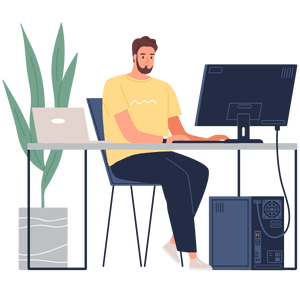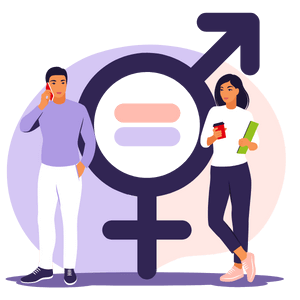Addressing the gender inequality caused by COVID-19
8 crucial tips for organisations
Featured UQ Business School experts: Associate Professor Terry Fitzsimmons and Dr Miriam Yates
Throughout the COVID-19 pandemic, Australian news cycles were dominated by facts, figures and statistics – case numbers, vaccination targets and death tolls.
What was largely overlooked was the human side, particularly how disparate the experience of living through a pandemic was for individuals.
Intrigued to learn more, The University of Queensland (UQ) Business School researchers Associate Professor Terry Fitzsimmons, Dr Miriam Yates and Professor Victor Callan partnered with the National Association of Women in Construction (NAWIC) and the Australian Gender Equality Council (AGEC). Together, they embarked on a nationwide study to determine the true impact of the pandemic on Australians.
Work-life outcomes for Australian women
The researchers surveyed over 2000 people and undertook 20 focus groups with more than 80 leaders representing every industry sector in Australia to understand the survey results.
They found the pandemic in Australia had an overwhelmingly greater financial and psychological impact on women than men, significantly affecting their overall employment, hours of work, domestic labour arrangements, mental health and wellbeing.
Lead researcher Dr Terry Fitzsimmons says the gender divide was a perfect storm of factors, many of which were out of women’s control, including their location, industry, work status and family situation.
“Everyone's experience of COVID was so different,” Terry says.
“We found 19 different variables that impacted how someone experienced COVID and how it affected their working life.
"Contributing factors that influenced gender inequality included whether you had children, what city you lived in, if you were in an essential industry, or whether you worked full time, part time or casually.
“Women are also disproportionately represented in the workforce in casual and part-time roles, yet these roles were the first to go during the peak of the pandemic.”
According to Dr Miriam Yates, the amalgamation of care, schooling, and working lives within the home put entire families to the test in terms of their psychological health and wellbeing.
“There’s little doubt that many men were also highly impacted by these shifts and changes. However, our report highlights that it was typically women taking the reins of the various – and often competing – work and family domains,” Miriam says.
Finding silver linings
National Association of Women in Construction Chair Christina Yiakkoupis says one silver lining uncovered in the report was that the pandemic forced workplaces to overcome dated misconceptions about employee productivity at home.
“Where working from home was possible, productivity benefited from reduced travel time,” Christina says.
“We have also heard of some organisations making positive and flexible options available to employees, such as job-share and part-time roles.
“Some of our members have established their own trade-based businesses to enable flexible hours to suit their circumstances.
“These changes have undoubtedly benefited women who have had to juggle working from home with domestic duties and home-schooling.”
Discover eight empowering resources to help women succeed in business
What can organisations do to reduce gender inequality?
The published report made several recommendations to address the ongoing impact of the pandemic, not just on women but on all workers and their families.
While the report calls on the Australian Government to initiate a national strategy for gender equality, it also outlines how the business sector can implement the recommendations.
Terry and Miriam share 8 top tips based on their findings to help organisations take steps to support their staff and reduce gender inequality.
 1. Offer early education and childcare options
1. Offer early education and childcare options
Securing flexible childcare options for employees is a scalable solution: large organisations can operate on-site childcare, while small-to-medium enterprises can join with similar businesses to offer collective care or help employees locate care.
Workplaces can also recognise the dual demands employees face when juggling work and childcare.
“Every firm can provide flexibility around drop off and pick up. Don’t schedule meetings at the end of the day, so employees don’t feel guilty about picking up their kids,” Terry says.
 2. Implement flexible and hybrid working policies
2. Implement flexible and hybrid working policies
Organisations have a responsibility to normalise flexible working arrangements and support employees to complete work in a way that suits their lives.
“It’s about organisations understanding that the traditional 9 to 5 office hours may not always suit all employees,” Miriam says.
“Workplaces should have documented policies and practices around different ways of working and embed them into their culture to support cohesive, supportive and engaged workforces.”
 3. Provide ongoing mental health support
3. Provide ongoing mental health support
Workplaces can foster a psychologically fit and healthy workforce by continuing to support employees’ mental health recovery and wellbeing.
“The trauma of the past few years doesn’t just disappear overnight; it will go on for years,” Terry says.
“Organisations need to provide employees with continued access to mental health support while they heal.”
Taking this a step further, Miriam says the workforces that will continue to thrive are those with a strong focus on psychological fitness through policies, programs and practices that support team members in their working lives and beyond.
 4. Address gender role stereotypes
4. Address gender role stereotypes
Workplaces must adopt a whole-of-system approach to undermine gender role stereotypes. In addition to an organisation’s policies, practices, systems and processes, they should address the implicit rules that govern workplace behaviour.
“Gender role stereotyping can include when meetings take place, who does the minutes, who gets teas and coffees, and who cleans up after the meeting. Firms need to be conscious of addressing this and any other form of stereotyping,” Terry says.
 5. Equalise parental leave entitlements
5. Equalise parental leave entitlements
Workplaces can play an instrumental role by providing women and men with equal access to parental leave and flexibility in when and how they take that leave. This approach gives parents more financial and professional control over how to re-engage in work.
“Importantly, this isn’t simply about instituting a policy that equalises parental leave but rather ‘demystifying’ the process of all parents taking leave to spend time with their little ones,” Miriam says.
 6. Apply a gendered lens to recovery investments
6. Apply a gendered lens to recovery investments
Businesses should consider the impacts of their recovery initiatives and strategies through a gendered lens.
“The temptation may be to look at the world before the pandemic and say, ‘let’s get on with it, let’s pick up where we left off’, but we learnt valuable lessons around inclusion in that time. We need to continue the investment made in engaging staff,” Terry says.
Miriam adds, “We’re suggesting that organisations consider gender when planning work and business initiatives so that all team members are empowered to participate and flourish into the future.”
“For example, when planning for shifts in operating hours, organisations could consider how their roster might affect those with care responsibilities. Our findings suggest this has often been women throughout the pandemic."
 7. Overhaul wage setting mechanisms
7. Overhaul wage setting mechanisms
To close the gender pay gap, workplaces should interrogate how wage-setting mechanisms are created, established and embedded.
“Reconsidering what activities, actions and work are valued through remuneration is a clear demonstration of the types of behaviour and practices that a workplace sees as important,” Miriam says.
“We need to see a wage setting system that recognises the value of work across – and not just within – industries; paying like for like in terms of qualifications and experience will see our care workers, the majority of whom are women, better paid.”
 8. Encourage employees to take up professional development opportunities
8. Encourage employees to take up professional development opportunities
The researchers discovered that many more women than men opted out of professional development opportunities during the pandemic, which Miriam says is “tough to reconcile”.
“Ensuring women can re-engage in their professional development is as much about organisations providing the instrumental support – such as funding and time – as the social and peer support to empower women to take the leap to more senior roles,” she says.
“A straightforward mechanism that organisations may look to introduce or reinvigorate is incorporating professional development for women into KPIs for managers.”
Learn how to land a seat at the boardroom table: tips from female ASX board members
The COVID-19 pandemic has undeniably impacted workers from all walks of life – particularly women. However, using the above tips, organisations can begin to address gender inequality and invest in their employees’ wellbeing.
Prioritise your professional development with UQ's MBA program
Associate Professor Terry Fitzsimmons

Associate Professor Terry Fitzsimmons is an Associate Professor in Leadership with The University of Queensland Business School and the UQ MBA program. He is the Director of the AIBE Centre for Gender Equality in the Workplace and Managing Director of the Australian Gender Equality Council (AGEC). He is also part of the Practice and Process Studies Research Hub.
Dr Miriam Yates

Dr Miriam Yates is an Adjunct Research Fellow with The University of Queensland Business School and a Research Fellow with UQ's Institute for Social Science Research. She is also a registered psychologist who consults with organisations on matters of strategic planning, diversity and inclusion, leadership development and psychological health and wellbeing at work.

